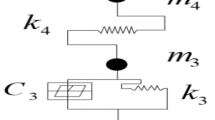Abstract
Mid-story isolation systems have previously been studied for decrease of the earthquake induced responses of high-rise buildings. The systems have been successfully applied to several buildings in Korea and Japan. Structural designers usually have to ensure that both the peak story and isolator drifts are within permissible limits. However, these two objectives conflict with each other. To solve this problem, a smart mid-story isolation system can be used for tall buildings. The system is composed of rubber bearings and magnetorheological (MR) dampers. The system was employed for an existing structure to reduce both the isolator and story drift. The control efficiency of smart mid-story isolator was evaluated based on a passive system. An artificial seismic load was made for numerical analyses for both systems. A fuzzy soft-computing technique with a multi-objective optimization was adopted to make control algorithm for decrease of both the inter-story and isolator drift. A numerical analysis results presents that the proposed method can effectively decrease the seismic-induced inter-story and isolator drift in the example of a tall building.









Similar content being viewed by others
References
Chey, M. H., Chase, J. G., Mander, J. B., & Carr, A. J. (2009). Semi-active control of mid-story isolation building system. In Asia Korean conference on advanced science & technology, Yanji, China.
Deb, K., Pratap, A., Agrawal, S., & Meyarivan, T. (2002). A fast elitist non-dominated sorting genetic algorithm for multi-objective optimization: NSGA-II. IEEE Transactions on Evolutionary Computation,6(2), 182–197.
Gasparini, D. A., & Vanmarcke, E. H. (1976). SIMQKE: User’s manual and documentation. Department of Civil Engineering, Massachusetts Institute of Technology.
Gordon, P. W., & Keri, L. R. (2012). A review of seismic isolation for buildings: Historical development and research needs. Buildings,2(3), 300–325.
Griffith, M. C., Aiken, I. D., & Kelly J. M. (1998). Experimental evaluation of seismic isolation of a 9-story braced steel frame subjected to uplift. Report no. UCB/EERC-88/05. Earthquake Engineering Research Center, University of California, Berkeley: California.
Hur, M. W. (2010). Construction of isolation device for DONG-IL High-Vill New City. Review of Architecture and Building Science,54(5), 81–86.
IBC. (2012). International building code. International Code Consortium.
Jun, D. H. (2013). Seismic response of R/C structures subjected to simulated ground motions compatible with design spectrum. The Structural Design of Tall and Special Buildings,21, 74–91.
Kim, H. S. (2014). Seismic response reduction of a building using top-story isolation system with MR damper. Contemporary Engineering Sciences,7, 979–986.
Kim, H. S., & Kang, J. W. (2012). Semi-active fuzzy control of a wind-excited tall building using multi-objective genetic algorithm. Engineering Structures,41, 242–257.
Kim, H. S., & Kang, J. W. (2017). Semi-active outrigger damping system for seismic protection of building structure. Journal of Asian Architecture and Building Engineering,16, 201–208.
Koo, J. H., Setareh, M., & Murray, T. M. (2004). In search of suitable control methods for semi-active tuned vibration absorbers. Journal of Vibration and Control,10, 163–174.
Sueoka, T., Torii, S., Tsuneki, Y. (2004). The application of response control design using middle-story isolation system to high-rise building. In Proceeding of the 13th world conference on earthquake engineering, Vancouver, BC, Canada.
Sues, R. H., Mau, S. T., & Wen, Y. K. (1988). System identification of degrading hysteretic restoring forces. Journal of Engineering Mechanics, ASCE,114(5), 833–846.
Tsuneki, Y., Torii, S., Murakami, K., & Sueoka, T. (2008). Middle-story isolated structural system of high-rise building. In Proceeding of the 14th world conference on earthquake engineering, Beijing, China.
Warburton, G. B. (1982). Optimum absorber parameters for various combinations of response and excitation parameters. Earthquake Engineering and Structural Dynamics,10, 381–401.
Xilin, L., Dong, W., & Shanshan, W. (2016). Investigation of the seismic response of high-rise buildings supported on tension-resistant elastomeric isolation bearings. Earthquake Engineering and Structural Dynamics,45, 2207–2228.
Yi, F., Dyke, S. J., Caicedo, J. M., & Carlson, J. D. (2001). Experimental verification of multi-input seismic control strategies for smart dampers. Journal of Engineering Mechanics,127(11), 1152–1164.
Acknowledgements
This work was supported by the National Research Foundation of Korea (NRF) grant, which is funded by the government of Korea (MSIP) (No. NRF-2017R1A2B4006226).
Author information
Authors and Affiliations
Corresponding author
Additional information
Publisher's Note
Springer Nature remains neutral with regard to jurisdictional claims in published maps and institutional affiliations.
Rights and permissions
About this article
Cite this article
Kim, HS., Kang, JW. Optimal Design of Smart Mid-Story Isolated Control System for a High-Rise Building. Int J Steel Struct 19, 1988–1995 (2019). https://doi.org/10.1007/s13296-019-00258-8
Received:
Accepted:
Published:
Issue Date:
DOI: https://doi.org/10.1007/s13296-019-00258-8




